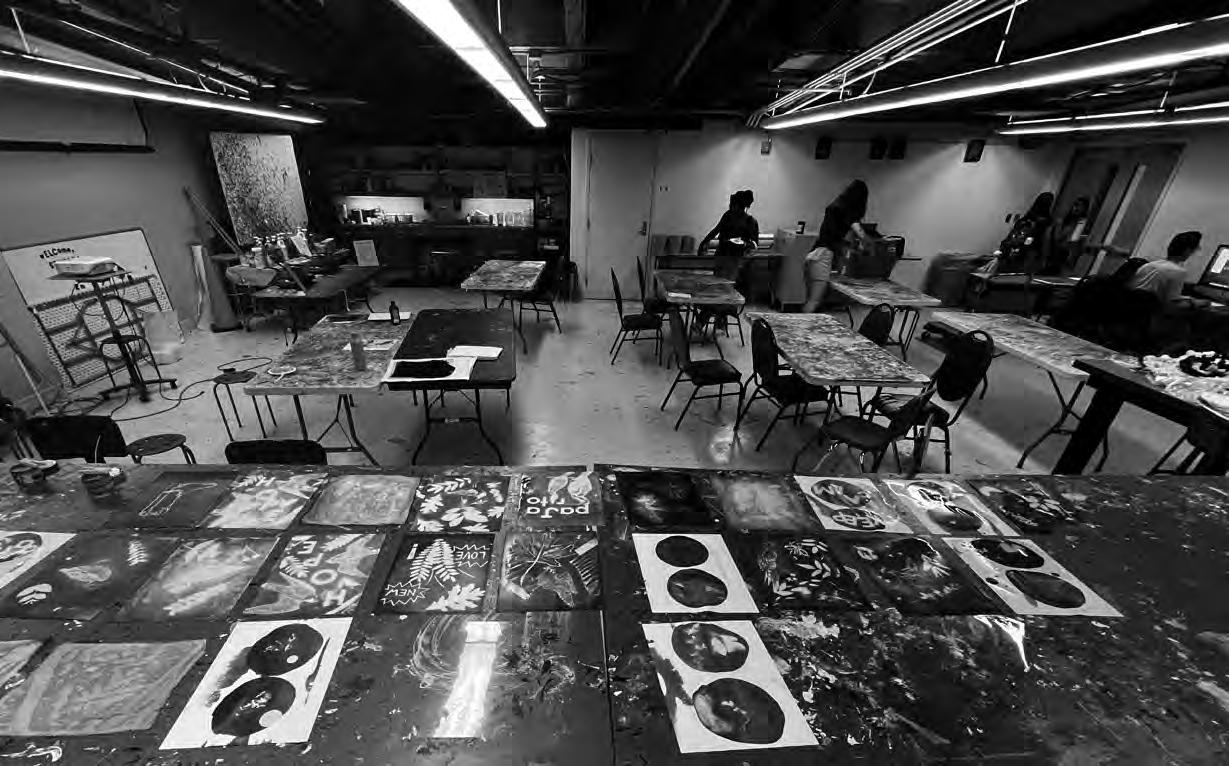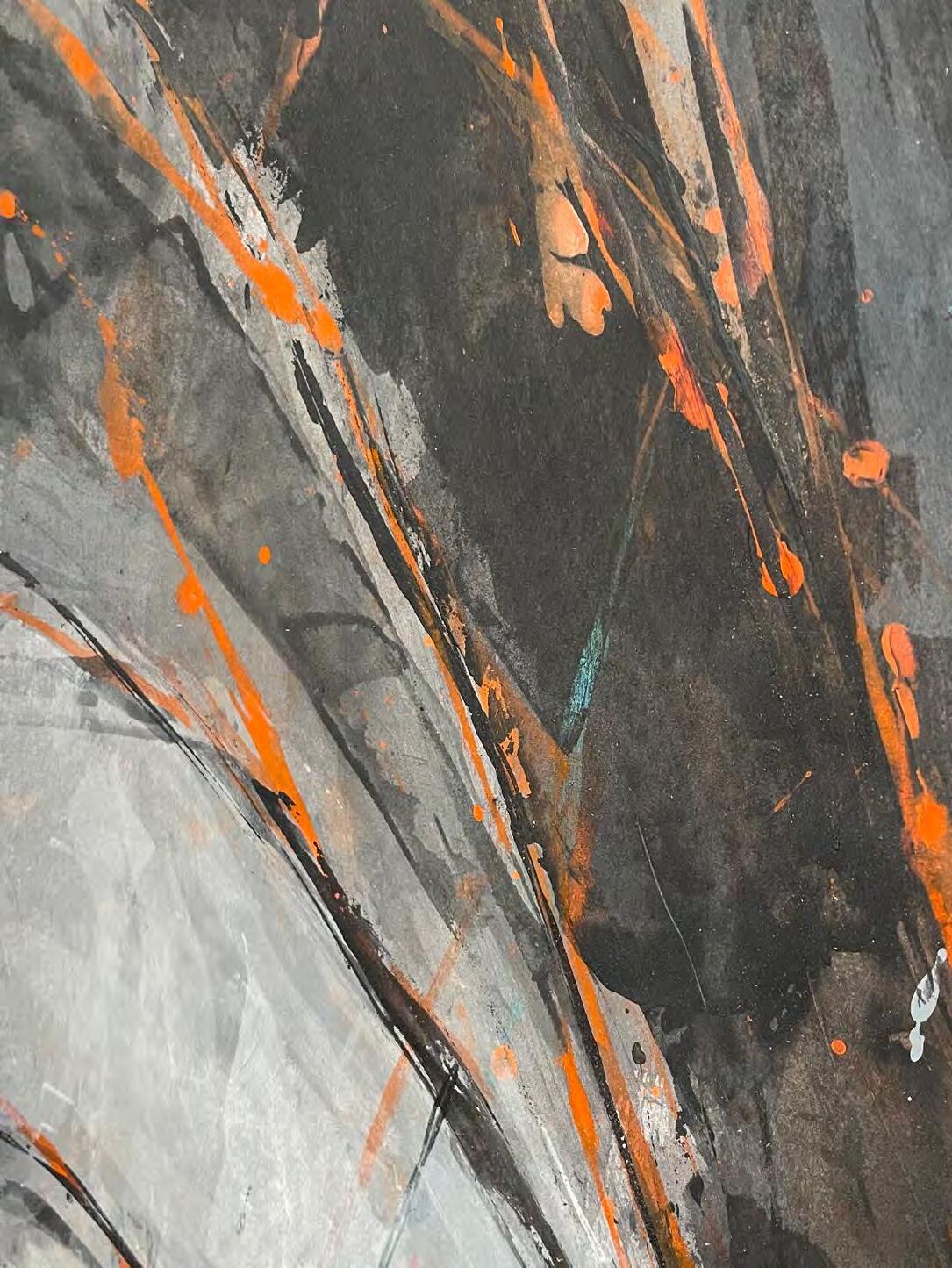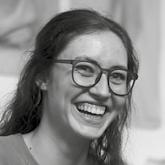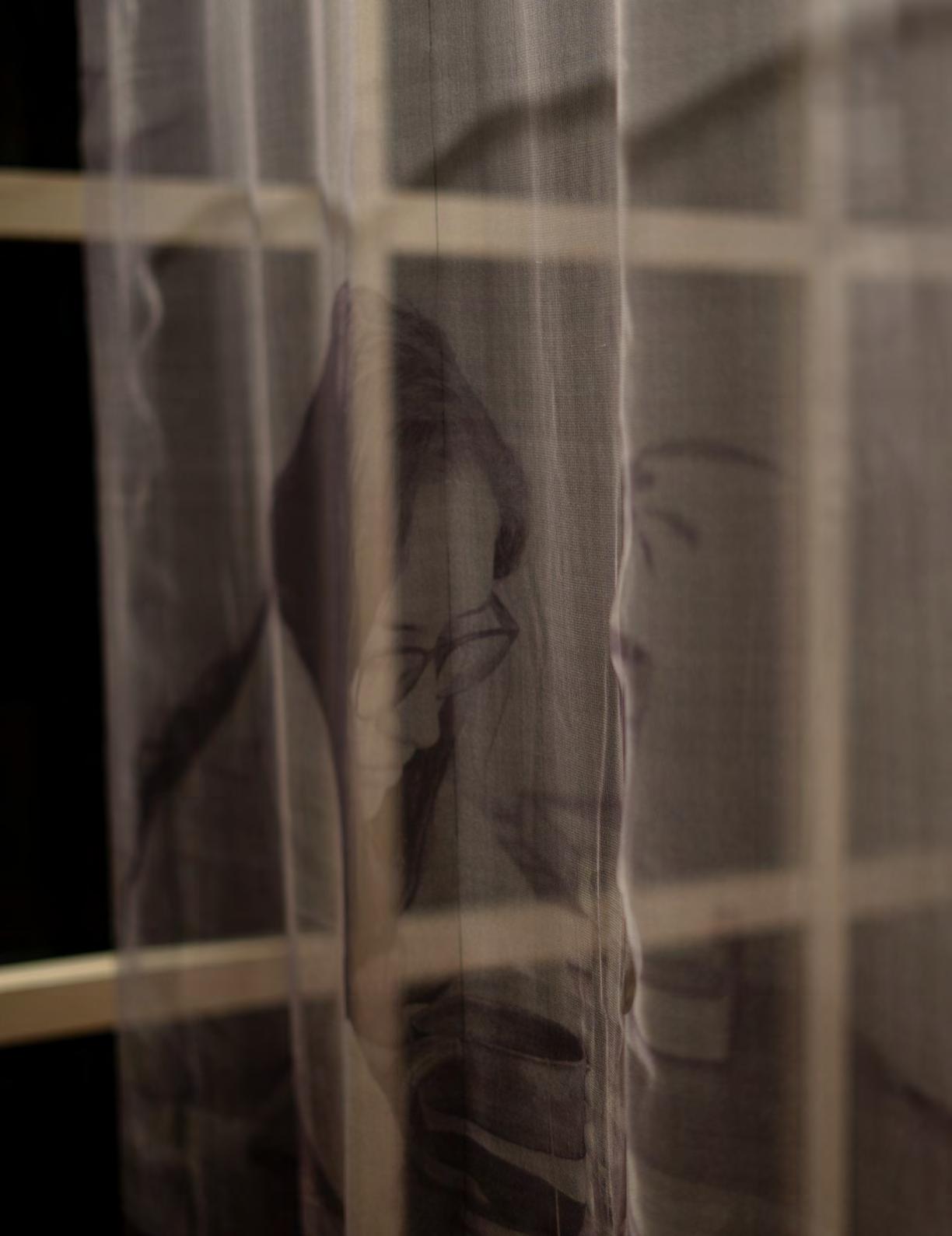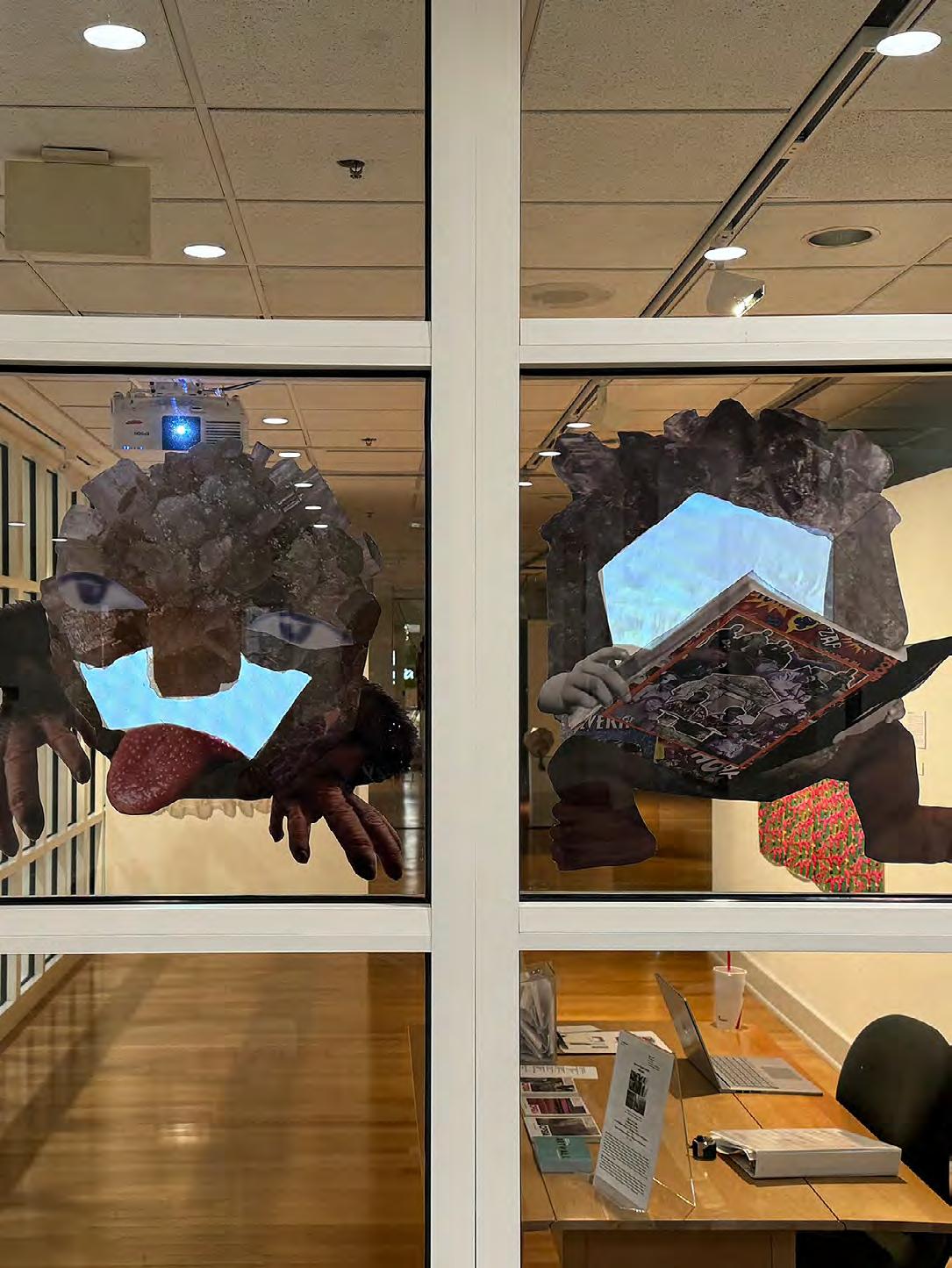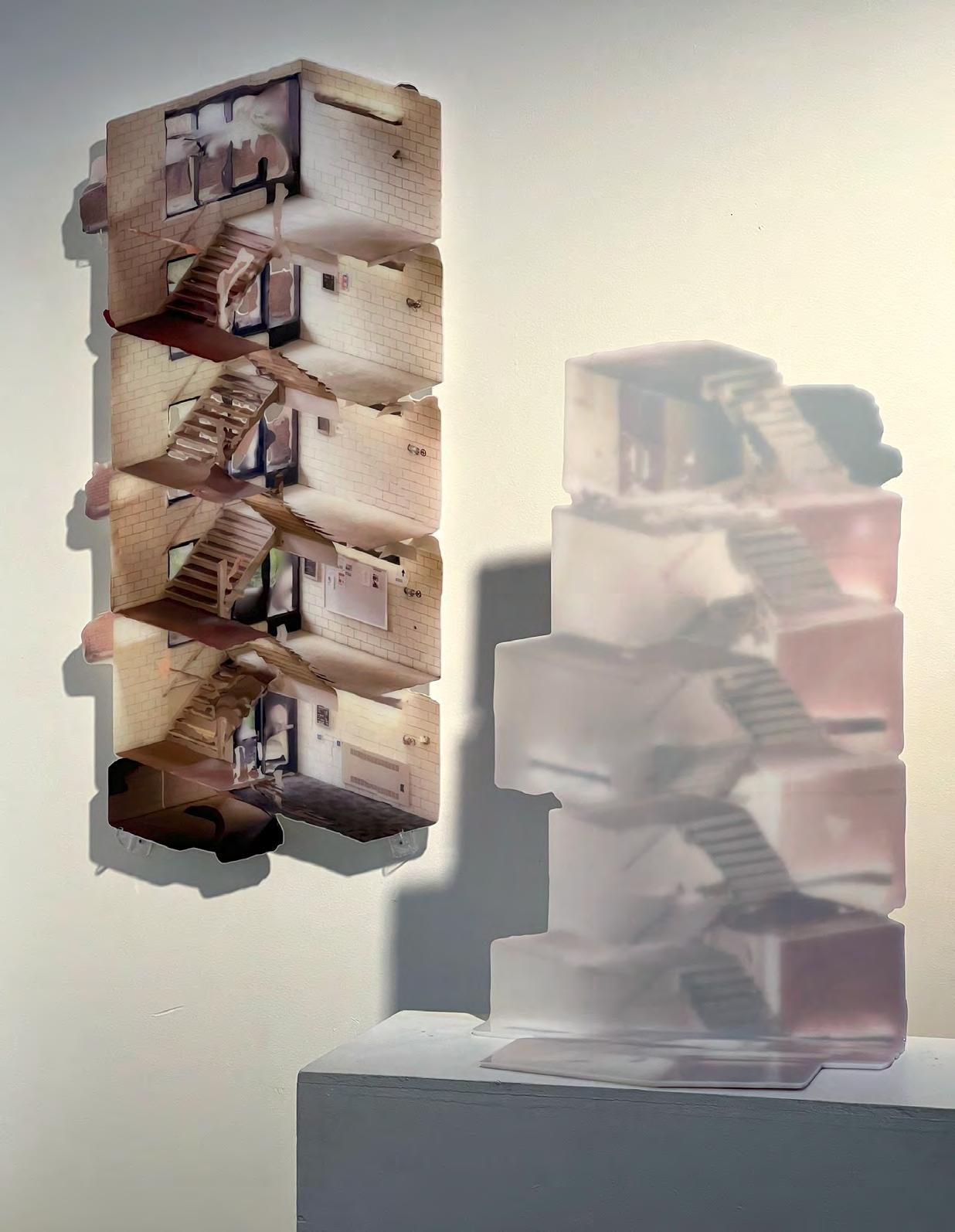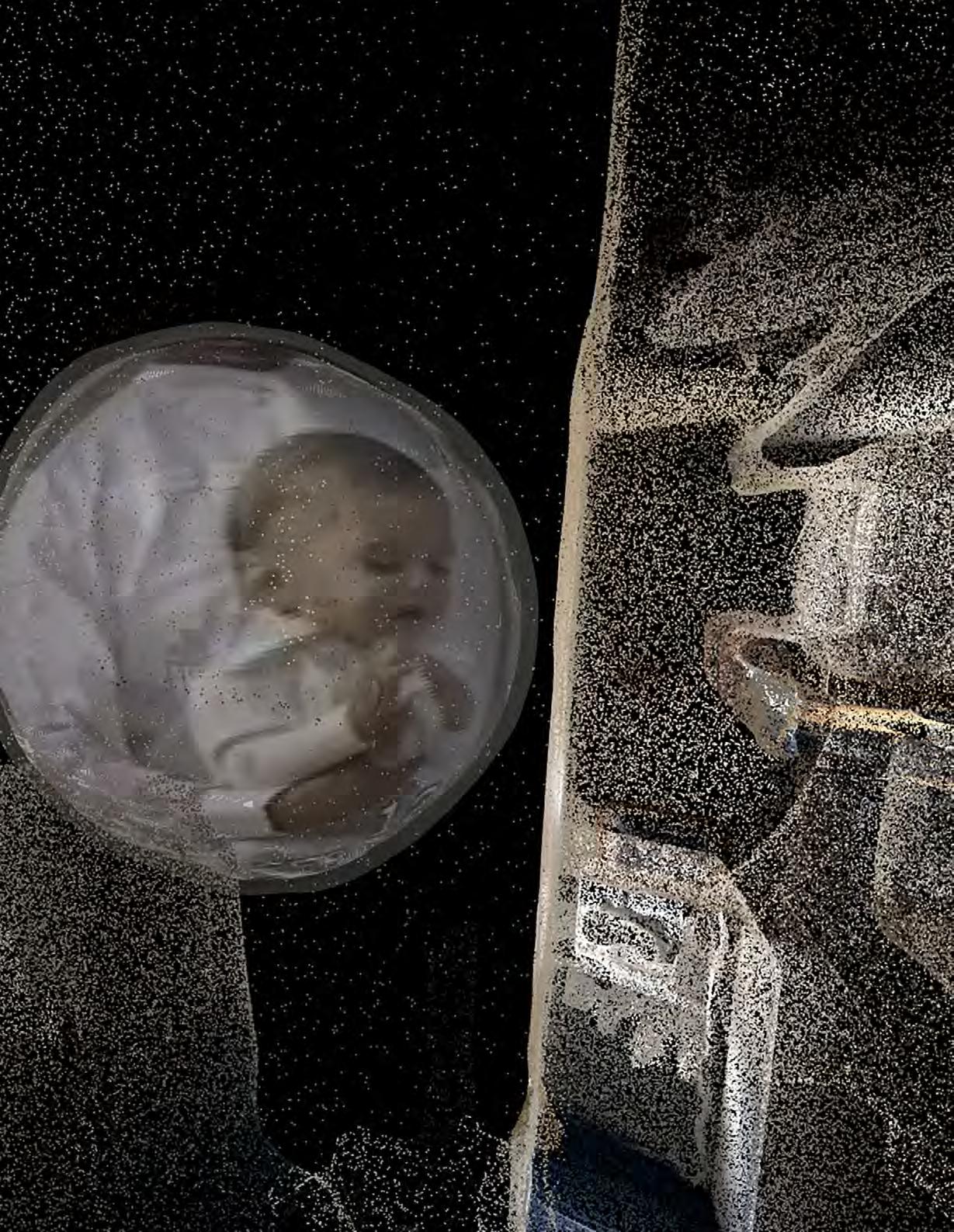DEPARTMENT OF ART +DEPARTMENT OF ART HISTORY AND ARCHAEOLOGY
Karin ZITZEWITZ
Shannon L. COLLIS
Taras W. MATLA
Ashley COPE
Georgia KERNS
Kenneth HILKER
Dan O. LEIZMAN
Tara YOUNGBORG
Valeria IACOVELLI
Maggie MASTRANDREA
Maura CALLAHAN
JooHee KIM
Trevon J. COLEMAN
Jill M. STAUFFER
Varvara TOKAREVA
Margaret WALKER
Mollye BENDELL
Mekayla MAY
Filippo GRASSI
Julia REISING
Jeffery HAMPSHIRE
ACKNOWLEDGMENTS
This project came to fruition thanks to the collaborative efforts of the graduate students from the Art and Art History & Archaeology departments at the University of Maryland, College Park. Under the guidance of Holly Miller, president of the Graduate Art History Association during the 2023-2024 academic year, we united with a shared interest of publishing a catalog of the exhibitions organized by the MFA artists during the Spring 2024 semester.
We extend our deepest gratitude to all those who made this catalog possible. We appreciate the efforts of Holly Miller, JooHee Kim, Benjamin Edwards, and Katherine Guinness in coordinating the inter-departmental meetings during the MFA Graduate Colloquium. We are grateful for the efforts and communications coordinated by Marco Polo Juárez Cruz, Maura Callahan, and Zoe Copeman, our catalog editors. Special thanks to Varvara Tokareva who designed this catalog.
As a shared effort between units at the University of Maryland, we appreciate the efforts and support of this project from the staff at the distinct galleries that hosted the MFA exhibitions. We thank Tara Youngborg at the Stamp Gallery, Taras Matla and Nan Zhong at the University of Maryland Art Gallery, and Mollye Bendell at the Herman Maril Gallery. We also appreciate the financial and academic support of Karin Zitzewitz (Chair of the Art History & Archaeology Department), Brandon Morse (Chair of the Art Department) and Shannon Collis (Graduate Program Director of the Art Department), which was instrumental in bringing this project to life.
FOREWORD
Karin Zitzewitz
Shannon L. Collis
FROM BENEATH, Taras W. Matla
Kenneth Hilker, Ashley Cope
Dan O. Leizman, Georgia Kerns
PALINOPSIA, Tara Youngborg
Margaret Walker, Valeria Iacovelli
Varvara Tokareva, Maggie Mastrandrea
Jill M. Stauffer, Maura Callahan
Trevon J. Coleman, JooHee Kim
AFTERIMAGE, Mollye Bendell
Julia Reising, Mekayla May
Jeffery Hampshire, Filippo Grassi
FOREWORD
Department of Art History and Archaeology
The University of Maryland Department of Art History and Archaeology is proud to support our graduate students’ collaboration with their counterparts in the MFA program in Studio Art. The essays in this catalog highlight the moment of viewing, when the artist’s act of creation is given over to the viewer, who takes up the task of meaning-making through interpretation. Art historians are, in essence, especially practiced viewers: people who have taken the time, done the work, and developed the language suitable for contextualizing individual works of art. The discipline’s insistent focus on the act of viewing—of standing in front of a work of art and looking very slowly while thinking very carefully about each choice an artist has made—gives it its grounding power. Art history is tethered to the object, but it understands that in each object lies a whole world.
Master’s and doctoral students in the Department of Art History and Archaeology are introduced to diverse approaches to art, archaeology, and visual culture across Europe, Asia, the African diaspora, and the Americas by faculty who are dedicated to advancing the discipline and mentoring students. Our students come to the department with a variety of professional and academic experiences and hold equal interest in employment within higher education and arts and cultural institutions. In support of their aims, the department provides all Ph.D. students with the opportunity to teach undergraduate courses and actively cultivates relationships with area museums and collecting institutions where students do research and hold internships. Students develop innovative research projects that serve as the foundation for long and productive careers in our disciplines. We are especially proud of the UMD Art History and Archaeology alumni network, which supports the practices of art history and archaeology both nationally and across the world.
The Department of Art History and Archaeology congratulates the students on their production of this beautiful catalog, which presents, documents and interprets the work of our graduate student artists and art historians.
Karin ZITZEWITZ, Professor and Chair, Department of Art History and Archaeology
FROM BENEATH
Thesis exhibition, University of Maryland Art Gallery
The MFA Thesis Exhibition is one of the most anticipated highlights of our academic year at the University of Maryland Art Gallery. It serves as a platform to showcase the innovative and rigorous artistic practices of our graduating MFA students, offering a unique lens into the future of contemporary art. Last year, we were proud to present From Beneath, an exhibition that reflects the depth and complexity of the graduate research undertaken by Kenneth Hilker and Dan Ortiz Leizman.
Hilker’s monumental wooden and metal sculptures challenge our perceptions of scale and proportion, inviting us to gaze upward and question our place within expansive spatial relationships. In like manner, his textured paintings evoke a rich and gestural energy, blending bold, sweeping movements with a dynamic interplay of abstraction and depth. Meanwhile, Ortiz Leizman’s multimedia installations create immersive environments that intertwine AI, tactile sound, and evocative imagery to explore themes of queer reproduction amidst the machinery of conflict. Their digital “wombs” provoke a profound dialogue about creation, identity, and resilience.
Together, these works compel us to embody new gestures—of looking, listening, and lying down—to engage more fully with the layered narratives these artists present. As you navigate this exhibition, I invite you to take your time, absorb the intricacies of their work, and reflect on the questions they pose about our shared humanity.
Congratulations to Kenneth Hilker and Dan Ortiz Leizman on reaching this significant milestone in their artistic journeys. We are grateful for their contributions to this exhibition and excited to witness the impact their work will have beyond these gallery walls.
TEXT BY Taras W. MATLA, Director, University of Maryland Art Gallery
ARTISTS: Kenneth HILKER, Dan ORTIZ LEIZMAN


There is something particularly exciting about taking your time. The more time you spend with monumental sculpture and expressive, unconventional paintings, the more you uncover. Kenneth Hilker (2024) has been creating art for as long as he can remember. He describes it as his “first language.” As a painting major at the Maryland Institute College of Art (MICA), he began exploring interpersonal relationships and the complexities that arise as a result. These ideas manifested themselves into landscapes, communicating his experiences in a way he describes as “non-invasive.” After earning his BFA degree in painting, Hilker spent the next thirty years working as a cabinet maker and exhibiting his art in Baltimore galleries, all while growing a family. Each of these experiences influenced Hilker’s paintings, transforming his work further and further into abstraction. Following the COVID-19 shutdown, Hilker decided to enroll in the University of Maryland MFA program, which provided him the space to expand his work forward, upward, and outward.
“From Beneath” (UMD Art Gallery, 2024) exhibits an array of Hilker’s work, from monumental wooden sculpture to expressive painting, all created with found materials. Hiker primarily sources the wood for his sculptures from the Baltimore nonprofit Second Chance, whose goal is to provide unemployed members of the local community with jobs in deconstruction, salvaging, and retail. He discovered that these materials had the ability to communicate the importance of experience in his work, as the unfamiliar, found materials guided his process through the qualities gained by their own experiences. Hilker’s sculpture responds to the age, shape, and wear of the materials that he sources, working to merge his own experiences with the rich history of his media. From his previous vocation as a cabinet maker, Hilker was familiar with the process of woodworking. However, the personality of the used wood, shaped by years of use, forced Hilker to interact with the material in a new way. To keep
his sculpture structurally sound, Hilker collaborated with his diverse supply of wood to form overlapping branches. Similarly, Hilker’s paintings featured in “From Beneath” are created with the assistance of his materials and tools. Rather than using familiar paintbrushes or palette knives, Hilker utilizes unconventional devices such as strips of rubber or spackling knives to create unexpected marks on salvaged tar paper. Hilker’s education in painting, his experience as a working artist, and the unpredictability of his new materials reveal the range of his artistic abilities, enhanced by the opportunity for experimentation provided within the MFA program at UMD.
Hilker’s work exemplifies the importance of taking your time. From his early artistic career, the challenges of the art world, the COVID-19 pandemic, and obtaining an MFA, Hilker’s work has evolved and changed, reflecting the respective experiences of his life. Hilker recommends taking one´s time when viewing his work, allowing it to cement itself in the observer’s own experiences. When asked about his plans for the future, Hilker did not seem worried. He has, of course, graduated from art school before. Rather, the aftermath of Hilker’s work will remain in those who take the time to truly appreciate the amount of experience and experimentation that went into creating his body of work.
TEXT BY Georgia KERNS, MA Student, Ancient Greek Art, Art History and Archaeology
LIST OF WORKS
PAGE 14: Book Ends scrap metal, reclaimed wood, 2024
PAGE 16, 17: Abstract Paintings (fragments) acrylic on paper, 2024
Kenneth HILKER, Painter, Sculptor, MFA Cohort 2021-24
If “Palinopsia” (STAMP Gallery, 2024) invites us to reflect on the illusory persistence of visual images, Margaret Walker (2025) addresses this concept by focusing on female identity and intergenerational bonds through the lasting emotional impact of photographic images. Central to her practice are family photographs and self-portraits that she transforms through other media, including ceramics and, in this instance, textiles.
Walker’s installations are made of flowy fabrics that fluctuate slightly as visitors walk by. Hanging loosely by the glass window of the gallery or left to drape on the floor, their waves and ruffles mimic the look of curtains and window treatments, bringing into the space an unexpected domesticity. By using a printer to transfer her own personal photographs onto the fabric, however, Walker activates these furnishings as tools of storytelling.
Walker grew up in Wisconsin, where her father’s amateur photography sparked her interest in image-making. Living far from the maternal side of the family in the Southwest, Walker had limited exposure to her mother’s Mormon heritage. One of the installations in the exhibition explores this connection: Living (2024), a set of four evenly sized sheets of silk gauze printed in black and white, presents nearly life-size portraits of the artist, her mother, and her grandmother. Suspended from the ceiling and spaced approximately one foot apart from each other, the sheets form a sequence of translucent layers. Despite being printed on mesh, each photograph maintains a wide tonal range and feels remarkably vivid: on the outer sheet, the artist’s mother appears as a young girl embroidering a piece of cloth; on another, an adult woman in profile—the artist’s grandmother—has her hair tousled in a headband and glasses perched low on the nose as she too is sewing or perhaps performing some minor repair. Behind her, Walker herself appears in profile, also wearing glasses and a hoodie raised over her head
while intently looking forward, perhaps studying or planning an artwork through a computer screen. When viewed frontally, however, the overlay of the translucent sheets compounds the photographs into a less clearly defined visual space simultaneously inhabited by all three women.
In a nod to The Kitchen Table Series (1990) — in which Carrie Mae Weems portrayed herself and others around a kitchen table to explore the Black female experience—the scenes in Walker’s Living also take place by the table, including one passed on to the artist by her mother. But unlike Weems’s sitters, Walker and her ancestors are entirely absorbed in pursuits (such as studying or sewing) that require sustained focus and that, oscillating between duty, creativity, and meditation, recall the spirituality of prayer. In Walker’s installation, thus, the kitchen table becomes the site of an intergenerational encounter where different modes of spiritual labor can be modeled and acknowledged, underscoring a connection among women whose stories, appearances, and gestures re-live in each other.
In a thoughtful exploration of latent images and shared identity, Walker rearticulated the theme of “Palinopsia,” challenging the stability of photography through the materiality of sheer fabric and, even more profoundly, revealing memory’s ability to bridge the inner tension between seeing and being.
Margaret WALKER, Visual Artist, Educator, MFA Cohort 2022-25
TEXT BY Valeria IACOVELLI, PhD Candidate,
Contemporary Art History and Theory, Art History and Archaeologyy
LIST OF WORKS
PAGE 20, 22 and 23: Living (fragments), photographic prints on silk gauze, 2024
“Soviet Nostalgia”—manipulated digital photomontages of group acrobatics—defines the work of Varavara Tokareva (2025). According to Tokareva, the phrase refers to the aesthetics of the bygone Soviet world, particularly the 1980 Olympic Games in Moscow. Human feelings of nostalgia, a sentimental longing for the past, are often inconsistent from the actual circumstances of events, quickly becoming sanitized and romanticized over the passage of time. Through a combination of artificial intelligence, graphic design, and advertising aesthetics, Tokareva explores nostalgia and her memories of often grim Soviet and post-Soviet aesthetics of the 1980s and 1990s, embracing the tension between fabricated narratives and realities, capitalism, utopia, and dystopia.
Soviet collective memory glorified the 1980 Olympic games as their pinnacle of exceptionalism. In the athletic events, Soviet athletes collected the most gold medals. However, this triumphant narrative is inconsistent with the reality that this victory was only made possible because of the boycott of the games by over sixty nations. Along with its historical significance, Tokareva feels a particular sense of nostalgia for this event because her parents met in attendance at the games. Because of the “lie” of the 1980 Olympics’ success, Tokareva employs this event as a metaphor for the changing Soviet society of her childhood. Using AI technology, she generates thousands of images of the opening ceremony to create a spectacle of human cooperation where the whole outweighs the individual, consistent with Soviet societal ideologies of collective work.
Tokareva experienced a similar tension between fabricated narratives and the experience of reality firsthand during her childhood when comparing her harsh experiences in post-Soviet Siberia with the enchanting images that appeared on her Funai television set—her “window for Western things.” In Tokavera’s manufactured images, which she
carefully selects from thousands of generated prototypes, AI exacerbates the dishonesty of the games. In the screenprint Utopia II (2024), hundreds of performers wearing identical pink uniforms stretch their arms out, connecting and forming one large, dizzying mass. Only upon closer inspection does the viewer notice uncanny details characteristic of AI images, such as faceless or headless figures. A deeper layer of illusion is woven into the medium of this work. When the viewer draws even closer, the colored dots that comprise the screenprint appear. After this realization, the viewer can recognize that many of the colors that seemingly appeared are just a trick of the eye; the image is formed only through cyan, yellow, magenta, and black inks. In Utopia I (2024), similar methods are employed in uncanny AI photos of the opening ceremonies, based on the actual event but portraying fictitious scenes. Each image of performers in matching monochrome costumes foregrounds the unified effort of the exaggerated acrobatics, briefly detracting the viewer’s attention from the absence of discrete features.
These images, superbly chosen and arranged by the artist, captivate the viewer and demand close attention. The experience of viewing these seemingly simple scenes warps as the reality of the artwork slowly reveals its falsehood. Every moment spent with these stunning yet eerie visuals prompts reflections on reality, memory, and truth.
TEXT BY Maggie MASTRANDREA, PhD student, Japanese Art, Art History and Archaeology
LIST OF WORKS
PAGE 24: Utopia II (fragment) serigraph on paper, 2024
PAGE 26: Utopia III (fragment) digital print on paper, 2023
PAGE 27: Utopia I (video still) video, 2023
Varvara TOKAREVA, Graphic Artist, Designer, MFA Cohort 2022-25
As the Earth hurtles toward a climate catastrophe, humans seem driven to record or fabricate what global capitalism has deemed unworthy of preservation. From photography to AI-generated virtual reality, digital processes have translated material environments into increasingly detailed, penetrable, and manipulable reproductions using technologies dependent on the Earth’s resources. The irony that environments must be mined and polluted to be digitally reborn propels the work of artist Jill McCarthy Stauffer (2025), whose installations engage the troubled entanglement of the organic and the technological as both physical and conceptual material.
Stauffer’s recent work emerged from personal memories forged during the pandemic, when the artist spent much of their time wandering the coastal environment surrounding their family’s Rhode Island home. The liminal and mutable space of the beach opens up to rich ecosystems with multiple temporalities beyond the reach of human perception. “An undercurrent to my work is looking for things that feel elevated and reference something bigger than ourselves—or a timespan bigger than our own—in the natural world,” Stauffer says.
Among the northeastern shore’s many inhabitants is the horseshoe crab, a species that, at more than 440 million years old, dwarfs the age of humankind dramatically. As Stauffer points out, horseshoe crabs predate trees and the North American continent. The mystery of these resilient organisms reaches a cosmic level with every new and full moon when they crawl onto the shores to engage in a mass spawning event. The phenomenon inspired Stauffer’s installation to be guided by the moon (2024), two dozen translucent, 3D-printed horseshoe crabs concentrically arranged on a bed of sand around a glowing orb. Illuminated from within, the creatures pulsate shifting hues of blue and violet, facing the moon as if called forward by its radiance. Stauffer invests the subject of the horseshoe
crabs’ lunar gathering with the spiritual dimension it clearly warrants: the concentric arrangement of forms evokes not only the circle’s symbolic equation with eternity, but also, as the artist notes, the radial glow of a gothic rose window.
But as with Stauffer’s other recent work — for example, I remember how the sanderlings go (2024), an installation of analog projections of seabirds whose motion is activated by the viewer’s movement—the experience of an ecological event is marked by its mediation. Technology inserts itself between the viewer and the nonhuman subject of the work; through exposed wires and printed plastic, its presence is palpable even in the works’ most dazzling and immersive moments. “I want to make that explicit: that it takes all this hardware to create something that’s really effortless and elegant in nature,” Stauffer says. Rejecting the possibility of neat resolutions or the wholesale dismissal of technology, their installations embrace ambivalence to the extent that they engage processes of technological reproduction in representing the natural while deliberately exposing its inadequacies. “I’m thinking about imitation as both an act for preservation and also a call for preservation, because I don’t think any digital representation of something is ever going to capture the original.”

TEXT BY Maura CALLAHAN, PhD
Student, Contemporary American Art, Art History and Archaeology
LIST OF WORKS
PAGE 29: To Be Guided by the Moon sand, masonite, 3D prints, LED strips, wire, circuit board, lamp, 2024
PAGE 30:
I Remember How the Sanderlings Go sand, LEDs, wire, circuit boards, acrylic, mat board, dichroic film, 2024
PAGE 30: If Everything Is Connected bristol board, LED strips, acrylic, wire, circuit board, 2024
Jill McCARTHY STAUFFER, Multimedia Installation Artist, MFA Cohort 2022-25
AFTERIMAGE
The MFA first-year exhibition, Herman Maril Gallery
The University of Maryland Maril Gallery opens each spring semester with an exhibition of work from incoming MFA students. The show represents not only the first exhibition of works from the new cohort to the campus community but also the potential of the new year and the conceptual path that lies ahead for our graduate students. In January of 2024, the incoming MFA exhibition was Afterimage, featuring works from Jeffrey Hampshire and Julia Reising.
Both artists exhibited work that questioned their own use of material in different ways. Reising recontextualizes objects that have already lived past lives, changing their form by cutting, rearranging, or casting them. Staircase balusters arranged as a scaffold support ghostly prints. Plastic netting guards the photograph of a clearing it could once have protected. Sod turns from earth to cloth in a large woven patch. Reising’s process often results in the deconstruction of the object into a new material, resulting in work that holds the history of the object and its future material potential in playful tension. For Hampshire, that materiality begins in the physical world and moves into digital space. In his 2023 work Sitzmark, Hampshire navigates a three-dimensional point cloud of his childhood home. In the version of this space mediated by 3D-scanning technology, interiors are distorted by the best guess of algorithms, retaining their
approximate form but in a different aesthetic than any human would have used to communicate the environment. The resulting video piece connects the form of the point cloud with the imprecise nature of memory.
The first-year MFA show is a highlight of the Maril’s programming every year thanks to talented artists such as Hampshire and Reising. Through this exhibition, I am grateful for the opportunity to watch them begin to actualize the ideas and aesthetics that they will develop over the course of their graduate education and on through their careers as professional artists.
ARTISTS: Jeffery HAMPSHIRE, Julia REISING
JANUARY 29, 2024— FEBRUARY 9, 2024
TEXT BY Mollye BENDELL, Exhibitions and Programming Director, The Herman Maril Gallery
“Who built me? and who is building me now?” are the questions that inform the artistic practice of Jeffery Hampshire (2026). These inquiries take shape in his work by investigating places and spaces — which are surely physical and geographical — but here also redefined as containers of memories, expressions of human communities, and loci of self-actualization.
In his 2021 piece Neighborhood Walks, Hampshire used lidar technology to guide his audience through walks in five places dear to him. The camera transports us to different viewpoints, and objects appear distorted. The digital display serves as a “copy” of the real world, visualizing the alterations and the stretches dictated by memory. After moving to Maryland in 2023, Hampshire delved deeper into his exploration of this theme. Firstly, the video piece Sitzmark, featuring various family videos floating in a placenta-like circular form reflecting the gallery space against the backdrop of a point-cloud model of his childhood home, powerfully and touchingly meditates on the relationship between spaces, memory, and identity. In Hampshire’s oeuvre, however, memory is not regret or nostalgia, but instead roots, momentum, and life projected toward a more humane future, as demonstrated by his recent disciplined exercise shown within Daily and Weekly Practices. In these works, digital scans of rooms and objects, produced by Hampshire himself or found in the Polycam database, are recombined through the skillful use of digital software, and then given physical form in two-dimensional prints or sculptural reproductions. Once again, unusual perspectives, unexpected compositions, and formal variations embody the flattening and distending effects of memory on places and things. The shapes thus obtained are perhaps less “objective”, but no less “real”; on the contrary, the filter of subjective experience yields scenes that, although mundane as a yellow sign signaling a wet floor, appear “heightened,” more authentic, more moving.
Hampshire’s Practices demonstrate his ongoing engagement with familiar themes, albeit with new techniques and modalities. In appropriating 3D scans created by other people, Hampshire aims to see “what people find interesting,” and always places great attention on the locality, only choosing scans from his places — either in Utah, Hawaii, or in the DMV area. This series of artworks continues Hampshire’s research on the interactions between humans and their environment, in an endless — and therefore contemporary, rather than past — process of signification.
Hampshire is well aware of the almost complete absence of human figures in his works. Although often “desert” like his native Utah, the places recreated by Hampshire vibrate and speak of the warm presence of those who inhabit or have inhabited them even without them present. We see this in the bathroom that remained unfinished for years in his childhood home or the dirty laundry on top of the washing machine captured in his Daily Practices, and even in the architectural skeletons created by Hampshire in his 2021 work Defining Lines: these figure-less spaces reverberate with the human events, the pains and the joys, the affections, and the wounds that they have witnessed.
Ultimately, within such a personal reflection — and perhaps precisely because Hampshire brings us into such an intimate world — his work takes on a collective significance. Within our atomized society, it forcefully poses to each of us the same questions: what meaning do the spaces and places we traverse and inhabit every day have? Where is home? What is community? And who builds us? Hampshire’s investigation has not yet concluded, and we look forward to seeing the continuation of his creative journey.
Jeffery HAMPSHIRE, Interdisciplinary Artist, MFA Cohort 2023-26
BY
TEXT
Filippo GRASSI,
PhD Student, Contemporary Chinese Art, Art History and Archaeology
LIST OF WORKS
PAGE 42: Staircase digital print on acrylic, 2024
PAGE 43: Head Space touchdesigner, video still, 2023
PAGE 43: Sitzmark touchdesigner, video still, 2023
University of Maryland 2025
